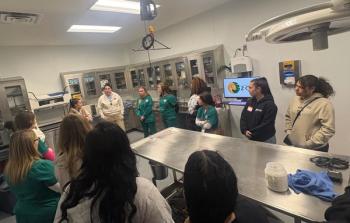
Diagnostic procedures (Proceedings)
Diagnostic procedures
Calcium
• Bone mineralization (skeletal structure)
• Ion transport across cells
• Cell contractility and secretion
• Hormone secretion
• Cell growth and division
• Neuromuscular transmission
Serum calcium
• 55% bound to albumin
• 35% ionized (active and regulated) form
• 10% "complexed" (to citrate, lactate, bicarbonate, phosphate)
Serum biochemical profile measures total calcium
Parathyroid hormone
• Parathyroid gland = main endocrine organ involved in control of Ca/P metabolism
• PTH actions
o Ca and P reabsorption from bone
o Increases Ca but decreases P reabsorption in kidneys
• Potent phosphaturic action*
o Increases activity of vit. D
• Increased absorption of Ca and P in GI
• Principle hormone in fine minute-to-minute blood calcium regulation
o Released in response to hypocalcemia
o Release inhibited by increased iCa, vit D
Vitamin D
• Activated vitamin D (calcitriol) increases Ca concentration by increasing absorption of Ca from the intestine, and by enhancing PTH action on bone and kidney.
• Cholecalciferol Calcidiol Calcitriol
• Vitamin D actions
o Increases GI absorption of Ca and P **
o Increases bone reabsorption
• Increases renal reabsorption
Note: pH effects
o ACIDOSIS increases IONIZED CALCIUM
o ALKALOSIS decreases IONIZED CALCIUM
Analytes for calcium status
• Total calcium
• Ionized calcium
• Inorganic phosphorus
• Parathyroid hormone (PTH)
• Parathyroid hormone related peptide (PTHrp)
• Vitamin D
Disorders of calcium
• Hypocalcemia
• Hypercalcemia
(refer to both total calcium abnormalities and ionized calcium abnormalities)
Hypocalcemia: hypoalbuminemia
• 55% of calcium is bound to albumin
• When albumin decreases, TOTAL calcium decreases
• Ionized calcium stays the same
• Benign
• Very common: most common cause of decreases in total calcium!
Correction formulas
• Use of correction formulas is not recommended
• Ionized calcium should be measured if true hypocalcemia is suspected
• (that said, if albumin is low, it is likely the reason for the hypocalcemia)
Common causes of true hypocalcemia
• Renal failure (acute and chronic)
• Pancreatitis
• Eclampsia
Renal failure and hypocalcemia
• Decreased calcitriol formation by kidney
o Decreased intestinal absorption of calcium
o PTH is less effective at releasing Ca from bone
• Increased phosphorus will decrease Ca (mass action, less important)
Eclampsia
• 1-3 weeks post partum
• Small breed dogs
• Loss of calcium in milk/skeletal development
• Seizures, trembling, twitching, shaking, and stiffness
• Treatment is IV calcium gluconate
Uncommon causes of hypocalcemia
• Hypoparathyroidism
• Ethylene glycol toxicosis
• Nutritional secondary Hyperparathyroidism
• Intestinal malabsorption (Yorkies)
• Phosphate-containing enemas (Fleet)
• Citrate toxicity (blood transfusions)
• Hypovitaminosis D
• Inadequate calcium intake
• Excess phosphorus
Clinical signs of hypocalcemia
• Signs occur when IONIZED calcium is low
• Nervousness, anorexia, stilted gait
• Hyperventilation, numbness
• Generalized tetany, seizures
Hypercalcemia
• Increased total calcium
• Increased ionized calcium
• Can serve as a marker of disease AND can cause disease
Hypercalcemia
• Estimate of overall occurrence
o 1.5% of all cases in one private diagnostic lab
• Significance of hypercalcemia
o Approx. 25% are young, growing animals
o Approx. 60% are transient (therefore not worked up)
o Approx. 15% persistent and pathological
Transient (inconsequential) hypercalcemia
• Post prandial
• Dehydration
• Lipemia (laboratory artifact)
• Young, growing dogs
• Addison's disease (hypoadrenocorticism)
Hypoadrenocorticism
• Second most common cause of hypercalcemia in dogs
• Total Ca increased +/- ionized calcium
• May be caused by increased renal reabsorption of calcium
• Responds to corticosteroid treatment and/or volume replacement
Causes of true hypercalcemia
• Hypercalcemia of malignancy: most common
• Primary hyperparathyroidism
• Idiopathic hypercalcemia of cats (diet?, rx pred)
• Renal disease (rare in small animals, common in horses)
• Vitamin D toxicosis
• Granulomatous inflammatory disease
• Grape and raisin toxicosis (renal failure - 1/2-1 oz)
Hypercalcemia
• PU/PD
• Lethargy, weakness, constipation
• Mineralization of soft tissue - when Calcium (mg/dL) x phosphorus (mg/dL) product > 60
• Calcium containing uroliths
Primary hyperparathyroidism: dogs
• Most often due to a solitary adenoma
• Autonomously secreting PTH
• Older dogs (>10)
Primary hyperparathyroidism: dogs
• ⇑ total calcium
• ⇑ ionized calcium
• ⇑ PTH
• ⇓ to normal phosphorus (can by high)
• ⇑ to normal calcitriol
• Undetectable PTHrp
Humoral hypercalcemia of malignancy
o Humoral Hypercalcemia of Malignancy
o Most common cause of hypercalcemia***
• Apocrine gland adenocarcinoma of anal sac
• Lymphoma
o Others (carcinoma in cats)
• Often associated with PTH-related protein (PTH-rP)
o Can measure in dogs and cats
Hypervitaminosis d
• Vitamin D toxicity
o Over supplementation with dietary source
o Rodenticides with Cholecalciferol
o Plants containing vit D glycosides
• Cestrum diurnum, Solanum malacoxylon
o Granulomatous disease
• Activation of vit D by macrophages
Hypervitaminosis d
• Vitamin D increases Ca resorption from bone
• Vitamin D increases Ca absorption from intestine
• Vitamin D increases phosphorus absorption from intestine
• Therefore, animals with hypervitaminosis D will have hypercalcemia AND hyperphosphatemia!
Chronic renal failure
• Hypercalcemia is common in horses
• Hypercalcemia seen in ~10% of dogs
o iCa usually normal to low**
o PTH often elevated
**this becomes important when distinguishing from hyperparathyroidism with secondary renal failure
Further diagnostics for hypercalcemia
• Ionized calcium
• CBC, serum chemistry profile, UA
• Thorough physical exam
o Palpate anal area, lymph nodes
o Radiography/ultrasound (parathyroid glands)
• Measure PTHrP
• Measure PTH
• Measure Vitamin D
Diagnostic approach
• Cancer hunt
• Renal disease?
• Mass in cervical region?
• History of vitamin D ingestion?
• If still suspect neoplasia, PTH-rp
Phosphorus
• Mineralization of bone
• Critical for high-energy phosphoryl units of metabolic intermediates
• Structural phosphoproteins and phospholipids.
• Inorganic phosphate anions play a role in acid base metabolism
Phosphorus regulation
• PTH decreases by decreasing renal tubular reabsorption
• Calcitonin decreases by inhibiting PTH-stimulated bone resorption, increasing movement into tissues, and decreasing renal tubular resorption of phosphorus.
• Vitamin D increases by stimulating absorption from intestine and kidney and inihibiting PTH synthesis.
Hypophosphatemia
• Primary hyperparathyroidism (renal loss)
• Hypercalcemia of malignancy (PTH-rp inhibits renal P reabsorption
• Vitamin D deficiency
• Respiratory alkalosis
• Decreased intestinal absorption of P
• Renal tubular defects (ie, Fanconi syndrome)
• Chronic renal failure in horses
Remember: sequela of hyperca
• Some causes of hypophosphatemia also cause hypercalcemia, such as primary hyperparathyroidism and hypercalcemia of malignancy.
• Hypercalcemia may result in mineralization of the kidneys, with resulting decreased GFR, and subsequent normal or increased serum P concentrations.
Hyperphosphatemia
• Decreased GFR, either as a result of prerenal azotemia (decreased blood flow to kidney), or renal disease is the most common cause of hyperphosphatemia.
• Ruptured bladder or ureter, or urethral obstruction will also cause retention of phosphorus.
Hyperphosphatemia
• Vitamin D intoxication
• Excessive P intake
• Primary hypoparathyroidism
Newsletter
From exam room tips to practice management insights, get trusted veterinary news delivered straight to your inbox—subscribe to dvm360.






